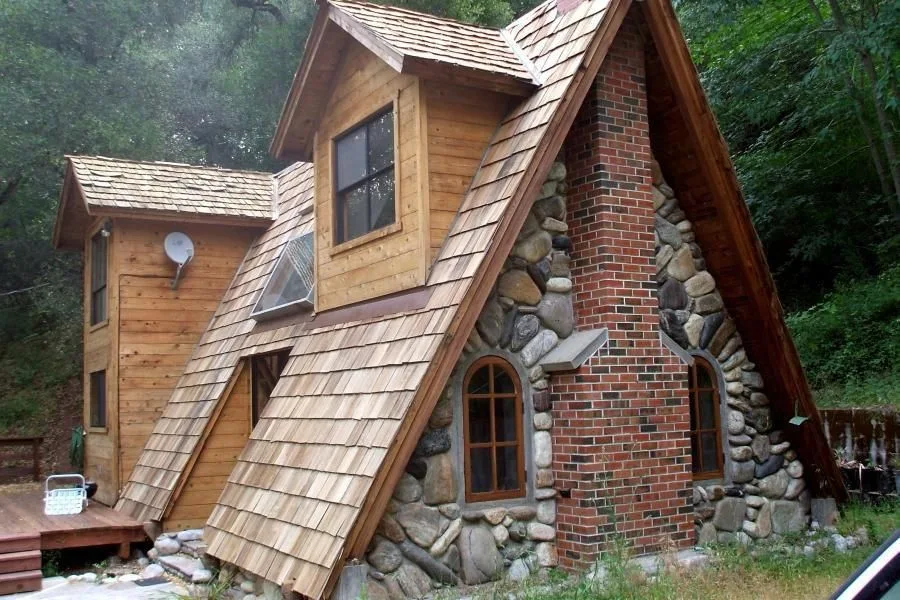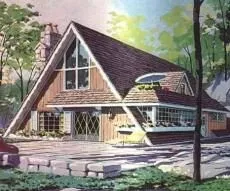Cozy Cottage Charm: A Frame House Plan with Dormers
By Abu Rizal at: February 09, 2021
A-frame houses have a unique and distinctive design, characterized by their steeply sloping roof that forms the shape of an "A."
This architectural style became popular in the 1950s and 1960s as a vacation home option for those looking for a rustic and cozy retreat.
A-frame houses can be built with or without dormers, but adding dormers to an A-frame house can provide additional living space and natural light.
What are Dormers?
A dormer is a windowed extension that projects from the slope of a roof. Dormers can be added to a house to provide additional living space, natural light, and ventilation.They can also add architectural interest and character to a home. There are several different types of dormers, including gable dormers, shed dormers, and eyebrow dormers.
Design Considerations
When designing an A-frame house with dormers, there are several things to consider. First, the size and placement of the dormers will affect the overall aesthetic of the house.Gable dormers, for example, have a peaked roof and can add a traditional and symmetrical look to the house, while shed dormers have a flat roof and can add a more modern and asymmetrical look.
Another consideration is the size of the dormers. Dormers can be small or large, and the size will affect the amount of natural light and living space they provide.
Larger dormers can also add more architectural interest and character to the house.
Finally, it is important to consider the function of the space created by the dormers. Dormers can be used to create additional living space, such as a bedroom, office, or playroom.
They can also be used to create a skylight or a window seat.
Conclusion
Adding dormers to an A-frame house can provide additional living space and natural light, as well as add architectural interest and character to the house.When designing an A-frame house with dormers, it is important to consider the size and placement of the dormers, as well as the function of the space created by the dormers.
With the right design, an A-frame house with dormers can be a cozy and rustic retreat that is perfect for a vacation home or a year-round residence.
What is an A-Frame House?
A-frame houses are a unique architectural style that is characterized by their triangular shape.The design features steep, sloping sides that come together at a peak, creating a shape that resembles the letter "A."
This design is often used in homes that are built in areas with heavy snowfall, as the steep sides help to shed snow and prevent buildup.
History of A-Frame Houses
The A-frame house design first became popular in the 1950s, when architects and builders began experimenting with new and innovative ways to create affordable, efficient homes.The design was particularly popular in the United States and Canada, and many A-frame houses were built in mountain and lakefront communities.
Advantages of A-Frame Houses
The A-frame design has several benefits, one of the main advantages is its ability to withstand heavy snow loads.The steep sides of the roof help to shed snow, preventing it from accumulating and causing damage.
Additionally, the triangular shape of the house allows for a large amount of natural light to enter the home, making it brighter and more energy-efficient.
The A-frame design also makes it easy to add additional living space to the home, such as a loft or a second story.
This can be a great way to add additional bedrooms or living space without having to build an entirely new house.
Disadvantages of A-Frame Houses
One of the main disadvantages of A-frame houses is that they can be difficult to heat and cool.The steep sides of the roof can make it difficult to install insulation and ductwork, which can lead to higher energy costs.
Additionally, the triangular shape of the house can make it difficult to furnish, as furniture may not fit well in the angled spaces.
Another disadvantage of A-frame houses is that they can be more expensive to build compared to traditional homes.
The unique design and construction of an A-frame house can make it more complex and time-consuming to build, which can lead to higher labor and materials costs.
Conclusion
Overall, A-frame houses are a unique architectural style that can offer many benefits, including energy efficiency, natural light, and the ability to withstand heavy snow loads.However, they can also be more expensive to build, difficult to heat and cool, and challenging to furnish.
If you are considering building an A-frame house, it is important to weigh the pros and cons and carefully consider the costs and challenges involved.
Are A-Frames Easy to Build?
A-frame homes are generally considered easy to build, as they have a simple triangular structure and typically use a minimal amount of materials.However, building any home requires proper planning, permits and following building codes, so it's important to consult with a professional or expert before starting construction.
Additionally, if you're planning on building an A-frame home in a snowy area, you'll need to take the added weight of snow on the roof into account when designing and building the structure.
How to Decide What A-Frame is Right for You
Purpose
What will you be using the A-Frame for? Will it be primarily for camping, or will you also be using it for other activities such as picnics or beach trips?Size
How many people will be using the A-Frame? Consider the number of people who will be sleeping in it, as well as the amount of gear that will need to be stored.Weather resistance
If you plan on camping in areas with inclement weather, make sure to choose an A-Frame that is weather-resistant. Look for features such as waterproofing and wind resistance.Price
A-Frames can range in price from budget-friendly to high-end. Determine your budget and look for an A-Frame that meets your needs within that budget.Weight and portability
If you plan on camping in different locations and need to transport the A-Frame, make sure to choose one that is lightweight and easy to set up and take down.Brand and reputation
Research different brands and read reviews from other customers to get a sense of the reputation and quality of the A-Frame.By considering these factors, you should be able to find an A-Frame that is the right fit for you and your needs.
How to Build an A-Frame House
- Plan and design the layout of your A-frame house. This includes deciding on the size and layout of the rooms, as well as any additional features you want to include, such as decks or balconies.
- Obtain the necessary permits and meet building codes. Building codes and regulations vary depending on location, so it's important to consult with local authorities to ensure your plans comply with these regulations.
- Prepare the building site. This includes leveling the ground, digging footings, and laying a foundation for the house.
- Erect the frame of the house. This typically involves assembling the triangular frame of the A-frame, using either prefabricated trusses or building the frame on site.
- Install the roofing and siding. This will typically involve installing shingles or other roofing material on the triangular roof, and siding on the exterior walls of the house.
- Add electrical, plumbing, and HVAC systems.
- Install interior finishes such as drywall, flooring and ceiling.
- Finish the exterior and landscaping.
It's also important to have proper planning, permits and following building codes. For a proper and safe construction,
it is recommended to consult with a professional or expert before starting construction.
The Different Types of A-Frame House Plans
There are several different types of A-Frame house plans, each with its own unique characteristics and features. Some of the most common types include:Traditional A-Frame
This is the classic A-Frame design, characterized by steeply pitched roofs that meet at a central peak. These plans often feature large windows and open floor plans.Reverse A-Frame
This design features the same steeply pitched roof as a traditional A-Frame, but with the peak at the back of the house rather than the front. This can be useful for homes located in areas with heavy snowfall.Modified A-Frame
This design features a more subtle slope to the roof, with the peak located at the front of the house. This design can be more practical for areas with lighter snow loads.Chalet A-Frame
This design combines the steeply pitched roof of an A-Frame with the traditional Swiss Chalet style, featuring large windows and a warm, cozy interior.Contemporary A-Frame
This design features a more modern, minimalist approach to the A-Frame style, with clean lines and an emphasis on natural light.Vacation A-Frame
This type of A-Frame is usually a smaller, one-story house that can be used for vacation or weekend getaways.Cabin A-Frame:
This type of A-Frame is usually a bit bigger than vacation A-Frame, and designed for more permanent use.By understanding the different types of A-Frame house plans, you can find the one that best fits your needs and preferences.
A-Frame House With a Loft
An A-Frame house with a loft is a variation of the traditional A-Frame design that includes an additional space above the main living area.The loft is typically accessed by a ladder or staircase and can be used for a variety of purposes such as a bedroom, office, or storage space.
A-Frame house with a loft typically have a steeply pitched roof that meets at a central peak, with the loft space located above the main living area.
The windows and skylights are usually placed in the front, providing natural light and a beautiful view.
These houses also tend to have open floor plans, making the most of the vertical space.
The advantage of having a loft in an A-Frame house is that it can provide additional living space without taking up valuable square footage on the main level.
Also, it can add a unique architectural feature to the house and a cozy feeling.
When designing an A-Frame house with a loft, it's important to consider the height and slope of the roof, as well as the structural integrity of the space.
It's also important to think about the purpose of the loft space and how it will be used, in order to plan the layout and design accordingly.
A-Frame With a Wraparound Deck
An A-frame with a wraparound deck is a type of architectural design where the main structure of the building is in the shape of an "A"and it has a deck that wraps around the entire perimeter of the building. This design allows for a large outdoor living space and can offer beautiful views.
It is commonly used for vacation homes or as a unique architectural feature in a residential home.
Tiny Home A-Frame Plans
Tiny A-frame homes are a popular style of tiny home due to their unique, triangular shape and efficient use of space.These homes typically feature a sloping roof that comes to a point, giving the home its "A-frame" shape. Some common features of tiny A-frame homes include:
- A compact, open floor plan
- Large windows to let in natural light
- Loft sleeping spaces
- Low-maintenance materials such as metal or standing-seam roofing
- Simple, minimalist design
Additionally, many architects and builders specialize in designing and building tiny A-frame homes.
A-Frame With a Walkout Garage
An A-frame house is a type of architectural design characterized by a steep, triangular shaped roof that begins at or near the foundation and extends up to the peak of the structure.A walkout garage is a type of garage that has a door or doors that open to the exterior of the home, rather than into the main living area.
So, an A-frame house with a walkout garage would be a structure that has a steep, triangular roof, and a garage that has an entrance that opens to the outside of the home, typically at the ground level.












